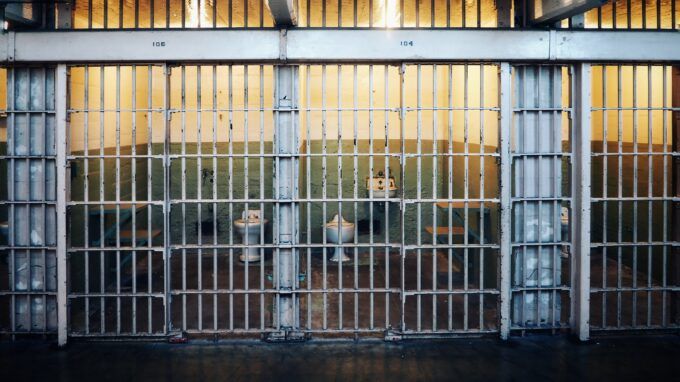
Image by Umanoide.
Orisanmi Burton’s new book, titled Tip of the Spear: Black Radicalism, Prison Repression, and the Long Attica Revolt changes the narrative around the 1971 Attica Prison Revolt in a substantial, even revolutionary way. In the text, Burton reframes the uprising at Attica State Prison in 1971 as part of an ongoing revolt. In doing so, he shifts the emphasis from the massacre by law enforcement that is most present in other tellings. In addition, his re-positioning of that incident as part of a longer, ongoing movement by Black, Latino and other prisoners for the abolition of prisons and jails in general makes the history of Attica a living fact.
One essential understanding is required to appreciate Burton’s narrative: prison struggles are never just about prison. Indeed, they are about the economics, politics and cultural realities of the system that locks people up. It is almost a cliché to state that in the United States, Black men are locked up more than any other demographic group. This is not only true in the present day; it is true throughout US history. From the chains and whips of the Atlantic slave trade to the plantations of the US south, the workhouses of the US north up to the maximum security regime of modern penology. The historical reasons for this are pretty straightforward. Kidnapped and brought to the Americas, African peoples have never been considered equal to those who enslaved them. Even though the legal apparatus making slavery the law of much of the land was uprooted in the nineteenth century after much blood was spilled, the societal dynamics remain such that a disproportionate number of Black people in the United States are treated differently than their white-skinned neighbors.
Burton sets the radical tone for his text early on. In his introduction he states, “Tip of the Spear argues that prisons are war.” He continues, calling incarceration a state strategy of “race war, class war, colonization and counterinsurgency.”(1) However, just as certainly that they are sites of repression and war, they are also sites where the state’s power can be contested. These contests are often in the rawest form possible. The massacre by the state at Attica remains a paramount example of this. However, as Burton makes clear in Tip of the Spear, the struggle against the state is part of daily life in prison. This struggle takes myriad forms on both sides. The prisoners wage what amounts to a guerrilla war against the authorities. Meanwhile, the authorities do their best at repressing that war. Sometimes this involves isolation of “troublemaker” prisoners; sometimes it involves manipulating racial and other differences among the prison population—a divide and conquer approach; other times it involves medicating prisoners. Behind each and every attempt to prevent a prison revolt or rebellion lies the omnipresent and real threat of violence by the state. These dynamics substantiate Burton’s claim that prisons are not just in a state of war but exist as a state of war. 
Tip of the Spear is both a history of the series of prison rebellions that took place around the United States in the late 1960s and early 1970s. The assassination of Black Panther and writer George Jackson in California’s San Quentin, the uprisings in New York City jails and state prisons in 1970 and the Attica Revolt are essential elements of the story the author wishes to tell. The sources he accessed to write this book are even more important. These include everything from official documents to best-selling books by Tom Wicker and Heather Thompson; interviews with former prisoners who were at Attica during the revolt and active participants in the prison struggles of the period. Among the latter are members of the Black Liberation Army (BLA), the Black Panthers, Young Lords and non-affiliated prison revolutionaries and their supporters. The role played by the media and liberal politicians is discussed in depth. That role was to provide a perspective that encouraged better conditions for prisoners, but supported the idea that prisons are necessary. This perspective was (and is) shared by liberal prison reformers. It’s a perspective that reminds us that the Attica rebellion was the bloodiest prison riot in US history while ignoring that it was the state’s enforcement apparatus that shed the majority of the blood. Burton’s approach—and that of the revolutionaries in the prison struggle—is one that calls for the prison walls to be torn down, not stabilized.
` One interesting discussion that reflects the changing nature of leftist conversations since the 1970s takes place in a chapter titled “Gender Wars.” A few paragraphs into the chapter, Burton quotes Black Panther/BLA member Dhoruba bin Wahad: “One of the things that scares white America is the thought of assertive Black manhood. They cannot deal with the threat that it represents to white male supremacy. (122) This informs the rest of the chapter, from its words regarding the sexual brutalization of the prisoners after Attica was forcefully recaptured to the discussion of the sexual and sexualized politics inside prisons and among prisoners that raise questions of masculinity, queerness, and numerous other manifestations. Burton argues these numerous manifestations are all a challenge to the hegemonic white male concept of sexuality that US society has traditionally encouraged.
There’s a lot to consider in this book. The writing is accessible even when it turns toward the academic. Not only is Tip of the Spear an important addition to the growing volume of literature regarding the role of prisons in the racist capitalist state that is the United States, the thesis of the text represents a major evolution in the historical representation of US prisons. Furthermore, it reasserts the importance of the radical and revolutionary movements of the 1960s and 1970s, and provides a necessary and eloquent reminder that prisons are both representative of and a fundamental part of the US imperial enterprise.
The post Prison is a State of War appeared first on CounterPunch.org.
This post was originally published on CounterPunch.org.

